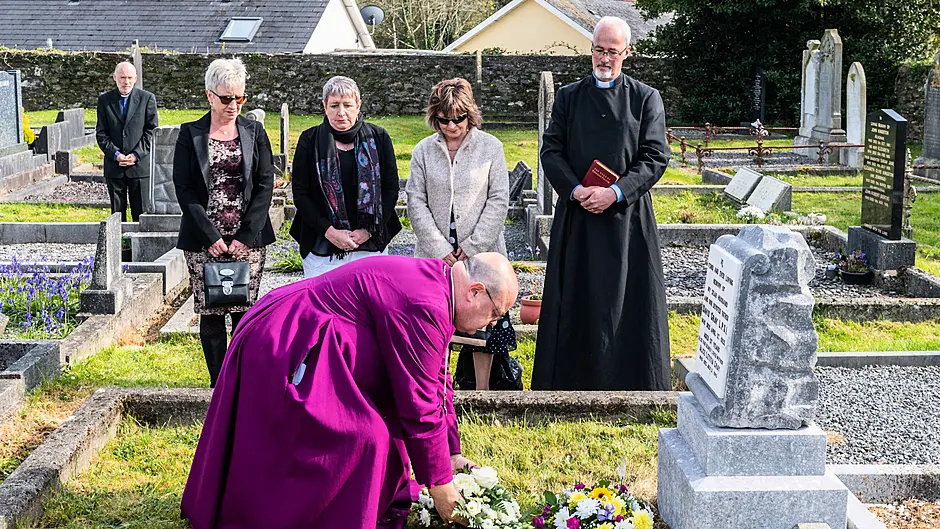The killing of 14 people locally in one single week back in 1922, including the deaths of a teenager and an octogenarian, is being sensitively marked by the Church of Ireland diocese this week
MARKING the centenaries of the Bandon Valley killings and the funerals which followed on those dates in 1922, Bishop of Cork, Cloyne and Ross, Dr Paul Colton, this week visited the West Cork parishes that were most closely affected by those events 100 years ago.
Writing in the Cork, Cloyne and Ross diocesan magazine this month, Bishop Colton said that the historiography of that period and those events in the Bandon Valley ‘has been written about extensively and debated with different narratives, emotions and responses elicited. Why it happened and what the motives of people were are elusive questions. What can we know with certainty at this remove? ‘
The Bishop emphasised, however, that at another level the facts were straightforward. He wrote: ‘At one straightforward level what happened is clear. In that week, 14 people were killed – Michael O’Neill, Thomas Hornibrook, Samuel Hornibrook, Herbert Woods, James Buttimer, David Gray, Francis Fitzmaurice, Robert Howe, John Chinnery, Robert Nagle, Alexander Gerald McKinley, John Buttimer, James Greenfield and John Bradfield.
‘Two of those were 16 years of age and the oldest was 82. Twelve were members of the Church of Ireland in this diocese. Attempts were made on others’ lives and they had to escape, many never to return. We know that in the years that followed many people from Cork, Cloyne and Ross felt insecure in this part of the world and left.’
Announcing his approach to the centenaries, Bishop Colton said he was not in a position to adjudicate on the historiography of that period. ‘As lead pastor in this diocese today, however, my primary duty, having consulted with the local clergy, who have listened to descendants, is to ensure that in prayer and liturgy, these people and events are appropriately remembered in the context of this Decade of Centenaries. With that in mind, as Bishop, I will be spending [this week] on pastoral visits to the parishes which were caught up in those events 100 years ago.’
Meanwhile, Barry Keane, author of Massacre in West Cork told The Southern Star that ‘little sophistication and more savagery were the hallmarks of the conflict in West Cork in the months leading up to the Civil War, as evidenced by the events in Ovens and Dunmanway in April 1922.’
He pointed out that acting commandant of the Cork 3rd IRA brigade, Michael O’Neill, was shot by Captain Herbert Woods at Ballygroman House in Ovens at 2.30am on the morning of April 27th. Members of the IRA surrounded the house later the same morning and after an intense gun battle the occupants Thomas Hornibrook, Samuel Hornibrook and Herbert Woods were arrested by the Irish Republican Police and taken to Newcestown where they were held for a few days before being shot and buried in nearby Farranthomas bog. A number of years later, the bodies were discovered and quietly buried in a nearby Church of Ireland graveyard. The exact whereabouts of the graves remains unknown. There is little doubt that the motive was straight revenge.
‘The following night saw the beginning of wide scale attacks on mostly Protestant families across West Cork. This level of attack on defenceless civilians was unheard of in the Irish War of Independence, and as virtually all the victims were Protestant, it raised fears that the killings were sectarian,’ Mr Keane added.
‘Specifically, on the night of April 26th–27th, three men were shot and killed in Dunmanway – local solicitor Francis Fitzmaurice was killed at 12.15am, chemist David Grey at 1am and retired draper James Buttimer at 1.20am. All were shot on their doorsteps. According to David Grey’s wife, his killers called him a “Free Stater” a number of times while they were shooting him. All this took place within 100 metres of the police station in Dunmanway, which was controlled by the anti-Treaty IRA under Peter Kearney, who failed to stop the shootings.’ During the second night of violence, John Chinnery and Robert Howe were shot in Castletown-Kinneigh to the north of Ballineen. Chinnery and Howe were next-door neighbours. ‘The pattern was the same in both cases,’ said Mr Keane. ‘Howe’s wife, Catherine, gave evidence to his inquest that he was attacked in the bedroom of his house at around 10.30pm, having refused to harness a horse. When he refused a second time, he was shot and killed. John Chinnery was shot while harnessing a horse for the raiders.
‘On the same night Alexander Gerald McKinley (the son of an RIC constable also named Alexander), who was sick in bed, was shot in Ballineen after 1.30am. His aunt was put out of the house and he was shot in the back of the head.’
At Caher, 3km west of Ballineen, John Buttimer and his farm servant James Greenfield were shot at 2am.
Church of Ireland curate Rev Ralph Harbord was shot (but survived) in Murragh on the same night. It now appears from the evidence of Mary Hyde to the Military Service Pensions Collection that the intended target was his brother who had been standing next to him and survived by jumping into the moat of the Georgian house.
‘Robert Nagle was killed in Clonakilty after 11pm,’ Barry continued.
‘Two men called to the house and, having questioned Robert about his age, doused the light in his bedroom and shot him.
‘His mother, who was in the house and witnessed the events, said one of the killers was drunk. He was shot in place of his father, Tom, the caretaker of the Masonic Hall, and on the same night the Masonic Hall was burned.
The final victim was John Bradfield of Killowen Cottage at Carhue, 4km west of Bandon.
More than 30 men of both religions were targeted, shot at, or forced to flee over the same three days, but all those killed were Protestant. The IRA commandant at Bandon, Tom Hales, rushed back from Dublin and ordered all guns to be handed in. He had been negotiating a truce between pro- and anti-Treaty forces, with Michael Collins among others, when he heard of the murders.
‘At this stage there is little doubt that the anti-Treaty IRA carried out these attacks or that they were a co-ordinated reprisal for the death of Michael O’Neill,’ added Barry. ‘While most people assumed at the time that these events were in response to the Belfast ‘pogroms’, this was probably at most a secondary motive in the killings but that in no way excuses what happened.’








